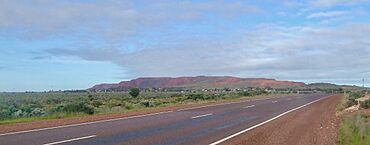Iron Knob facts for kids
Quick facts for kids Iron KnobSouth Australia |
|||||||||||||||
|---|---|---|---|---|---|---|---|---|---|---|---|---|---|---|---|
 |
|||||||||||||||
| Established | 11 February 1915 (town) 29 July 2004 (locality) |
||||||||||||||
| Postcode(s) | 5611 | ||||||||||||||
| Elevation | 66 m (217 ft) | ||||||||||||||
| Time zone | ACST (UTC+9:30) | ||||||||||||||
| • Summer (DST) | ACST (UTC+10:30) | ||||||||||||||
| Location |
|
||||||||||||||
| LGA(s) | Pastoral Unincorporated Area | ||||||||||||||
| Region | Far North | ||||||||||||||
| County | Manchester | ||||||||||||||
| State electorate(s) | Giles | ||||||||||||||
| Federal Division(s) | Grey | ||||||||||||||
|
|||||||||||||||
|
|||||||||||||||
| Footnotes | Adjoining localities | ||||||||||||||
Iron Knob is a small town in South Australia, Australia. It's located on the Eyre Peninsula, near the Eyre Highway. In 2006, about 199 people lived there. The town got its name because it's close to huge amounts of iron ore. One famous spot is called Iron Monarch, which is a big hill of iron ore sticking out of the flat land.
Contents
Iron Ore Mining History
The name Iron Knob first appeared on maps in 1854. A mining company called BHP claimed the first mineral rights here in 1897. Mining officially began in 1900.
Early Transportation of Ore
At first, iron ore was carried by bullock wagon to Port Augusta. From there, it was loaded onto barges. Later, in 1903, a railway was built to Whyalla. The ore was then shipped from Whyalla to Port Pirie. In Port Pirie, it was used as a flux in a lead smelter. A flux is a material that helps metals melt more easily.
In 1901, the BHP Whyalla Tramway was finished. This railway connected Iron Knob to Hummock Hill, which was later renamed Whyalla. Wharves were built in 1903. These allowed ships to load the ore directly. The ships then carried the ore across Spencer Gulf to Port Pirie.
High-Quality Iron Ore
The iron ore from Iron Knob was very special. It was super high quality, with over 60% pure iron. This amazing quality helped Australia start its own steel industry. Iron Knob supplied iron to big steelworks in Newcastle and Port Kembla in the 1910s and 1920s. It also supplied the Whyalla Steelworks starting in the 1930s. The ore was always sent by rail to Whyalla. From there, it was either smelted (melted down to make metal) or shipped out.
Iron Ore for Famous Structures
A lot of the steel for the Sydney Harbour Bridge came from Iron Knob. About 21% of the steel needed for the bridge was mined here. It was then smelted at Port Kembla. The rest of the steel for the bridge came from Britain.
Exporting Iron Ore
In the 1920s, Iron Knob's iron ore was sent to countries like the Netherlands and the United States of America. In the 1930s, it was also exported to Germany and the United Kingdom.
Before World War II, iron ore from Iron Knob was also sent to Japan. In one year (1935–36), over 290,000 tonnes of ore went to Japan from Whyalla. This became a concern because Australia's known iron ore supplies were limited. Japan was also seen as an "aggressor" nation at the time.
Iron Ore Production and Discovery
By 1937, Iron Monarch was producing about 2 million tonnes of iron ore each year. In 1939, people in England said it was the highest-grade iron ore deposit in the world. Even in 1943, the ore from Iron Knob still had about 64% pure metal. By 1949, almost all of Australia's iron ore came from Iron Knob and nearby mines in South Australia.
The Broken Hill Proprietary Company found more iron ore deposits nearby. These included Iron Baron, Iron Prince, Iron Queen, Iron Knight, Iron Duchess, and Iron Duke.
Mine Closure and Reopening
Mining for iron at Iron Knob and Iron Monarch stopped in 1998. When the mining stopped, the town's population dropped to about 200 people. It looked like Iron Knob might become a ghost town. However, because housing prices were rising in other places, new people moved to Iron Knob. They were looking for affordable homes. You could buy a house for about A$35,000–70,000, and empty land for less than A$15,000.
In 2010, a company called Onesteel (later Arrium) announced they would return to Iron Knob. They planned to reopen the Iron Monarch mine. Arrium got the mine ready again in 2013. As of 2015, both Iron Monarch and Iron Duke are still producing iron ore. This ore is used for export and for making steel at the Whyalla Steelworks.
Transporting the Ore
In the very early days, iron ore was moved by oxen to Hummock Hill (now Whyalla). About 300 long tons were delivered in a good week. Building a private railway made transport much faster. By 1939, trains were carrying 9,000 long tons of ore daily to Whyalla. Each train could carry about 2,000 long tons.
Ships owned by BHP Shipping were often named with "Iron" at the start. Some of these ships were even built at the Whyalla Steelworks.
Sometimes, Highway 1 near Iron Knob closes. This happens when controlled explosions are used in the mining area.


